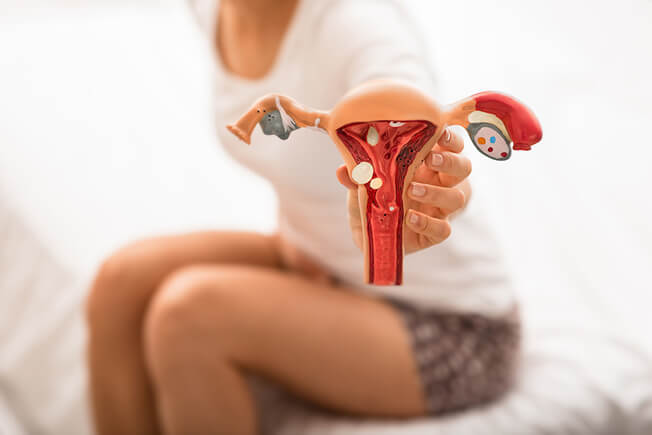What you should know about the four stages of endometriosis and how to get treated

Endometriosis is a condition in which tissue that's similar to the tissue that lines the uterus winds up outside of the uterine cavity. That tissue can implant and grow throughout the body, including the ovaries and fallopian tubes, bladder, bowls, even the lungs.
It's unclear what causes endometriosis and why some women develop more severe cases than others. What we do know is that endometriosis creates a state of cyclical or chronic inflammation, and that inflammation is what triggers the hallmark symptoms of endometriosis, all of which are related to pain.
What are the four stages of endometriosis?
The four stages of endometriosis were established by fertility doctors in the 1970s. Before this staging system was established, there was no consistent, reliable way for doctors to talk about endometriosis.
According to Jordan Klebanoff, MD, a minimally invasive gynecologic surgeon at Main Line Health specializing in endometriosis care, there are some limitations with this staging system—mainly, that it was designed to communicate to patients how their endometriosis inflammation would impact their ability to conceive.
"This staging system was developed purely from a standpoint of communicating fertility information for patients with the disease," Klebanoff says.
The doctors who defined the four endometriosis stages looked at three specific locations of where the condition exists: the ovaries, the fallopian tubes, and the peritoneum, which is the tissue that lines the entire pelvic area and abdomen.
According to Klebanoff, then they assigned a scoring system based on the size, location, and depth of the disease. That score indicates whether a patient has stage 1 endometriosis, stage 2 endometriosis, stage 3 endometriosis, or stage 4 endometriosis.
Related: Blog – What you need to know about endometriosis and fertility
While the correlation between each stage of endometriosis and a patient's ability to conceive isn't perfect, the staging system does help doctors determine if the disease may make it harder for certain patients to conceive. The later the stage, the harder it typically is to conceive—but that doesn't mean it's impossible.
That said, the disease stage does not necessarily determine the symptoms or the recommended treatment. Symptoms can include severe pain during menstruation, pain or blood with bowel movements, pain with urination, nausea, and bloating.
"You could have people that have stage 4 disease and have very little impact on their quality of life. And you could have people with debilitating pain completely affecting their quality of life that have stage 1 disease," Klebanoff says.
It's also unclear if and how the disease progresses from one stage of endometriosis to another. Most commonly, people present with stage 1 or stage 2 endometriosis, according to Klebanoff.
But there are plenty of people with more advanced stages of the disease. Depending on the stage, the condition can be treated with medical management (like hormonal birth control) or surgery to remove the tissue, which varies in complexity based on the disease state. Types of surgery include laparoscopy for endometriosis and ovarian cysts, and endometrial ablation.
What does advanced endometriosis look like?
It's crucial to recognize that endometriosis looks and feels different from person to person.
Jazzmine Myers, a 30-year-old woman who was recently diagnosed and treated for late-stage endometriosis, has had painful periods for as long as she can remember. She'd mostly been able to control her pain with over-the-counter pain relievers, but in early 2020, the nausea and pain that accompanied her menstrual cycles began to intensify, especially in her lower abdomen. Within months, the pain had become so severe that Myers was having difficulty doing simple tasks like walking.
Related: Blog – Endometriosis myths to stop believing right now
Like many women, Myers' journey to get a diagnosis was a long and complicated one. It took more than a year—and multiple doctors, ultrasounds, diagnostic tests, visits to the emergency room, and misdiagnoses—to finally learn that she had late-stage endometriosis.
"I was in a lot of pain and I wasn't getting the help that I needed," Myers says. After more tests, Myers was informed that her endometriosis had spread to her uterus, bowels, and bladder, and that she would need surgery. Myers was eventually referred to Dr. Klebanoff.
According to Myers, Klebanoff looked at her imaging scans, evaluated her medical history, and told her that the endometriosis was severe. He assured her that even though it might not be an easy journey, he and a team of surgeons would do everything they could to help her recover.
Myers received surgery to remove the endometriosis in a way that would preserve her ability to have children. After recovering from surgery, the pain became much more manageable.
"The pain did not compare to the pain that I felt when I was feeling that menstrual pain—and that speaks a lot," she says.
Recovery from stage 4 endometriosis
Throughout the entire process, Klebanoff was available to answer Myers' questions and concerns. During recovery, he provided resources and support groups to guide her. Together, Klebanoff, his surgical team, and Myers also mapped out what her future treatment plan might look like in the event that her endometriosis came back.
Myers' advice to women who think they may have endometriosis is to listen to yourself.
"Advocate for yourself. If you know something isn't right, then there's something that's not right," she says.
"I am extremely grateful to Dr. Klebanoff and his team. He changed my life," Myers adds. "My quality of life is better. It's not the end of the road for me, but already I feel ten times better."
Next steps:
Make an appointment with Jordan Klebanoff, MD
Learn more about the Advanced Gynecology Program at Main Line Health
What is adenomyosis?
 Content you want, delivered to your inbox
Content you want, delivered to your inbox
Want to get the latest health and wellness articles delivered right to your inbox?
Subscribe to the Well Ahead Newsletter.
